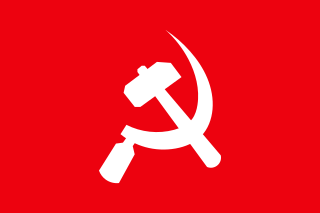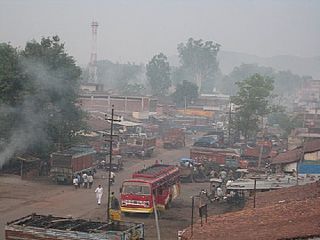
Jharkhand is a state in eastern India. The state shares its border with the states of West Bengal to the east, Chhattisgarh to the west, Uttar Pradesh to the northwest, Bihar to the north and Odisha to the south. It is the 15th largest state by area, and the 14th largest by population. Hindi is the official language of the state. The city of Ranchi is its capital and Dumka its sub-capital. The state is known for its waterfalls, hills and holy places; Baidyanath Dham, Parasnath, Dewri and Rajrappa are major religious sites. Jharkhand is primarily rural, with about 24% of its population living in cities.

The Communist Party of India (Maoist) is a banned Marxist–Leninist–Maoist communist political party and militant organization in India which aims to overthrow the "semi-colonial and semi-feudal Indian state" through protracted people's war. It was founded on 21 September 2004, through the merger of the Communist Party of India (Marxist–Leninist) People's War (People's War Group) and the Maoist Communist Centre of India (MCCI). The party has been designated as a terrorist organisation in India under the Unlawful Activities (Prevention) Act since 2009.

Latehar is a town which is a headquarter of Latehar district of Jharkhand state, it is known for its natural environment, forest, forest products and mineral deposits. Latehar remained a part of Palamau District as a sub division since 1924. It was elevated from sub divisional status to a district on 4 April 2001, vide Jharkhand Government Notification No 946 dated 04.04.2001. Latehar is located on the north–west corner of Jharkhand in the Palamau Commissionary. It is surrounded by Ranchi, Lohardaga, Gumla, Palamu and Chatra district apart from Chhattisgarh state and district headquarters is situated at 84.51198 East Longitude and 23.741988 North Latitude.

Palamu district is one of the twenty-four districts of Jharkhand, India. It was formed in 1892. The administrative headquarters of the district is Medininagar, situated on the Koel River.

The Naxalite–Maoist insurgency is an ongoing conflict between Maoist groups known as Naxalites or Naxals and the Indian government. The influence zone of the Naxalites is called the red corridor, which has been steadily declining in terms of geographical coverage and number of violent incidents, and in 2021 it was confined to the 25 "most affected" locations, accounting for 85% of Left Wing Extremism (LWE) violence, and 70 "total affected" districts across 10 states in two coal-rich, remote, forested hilly clusters in and around the Dandakaranya-Chhattisgarh-Odisha region and the tri-junction area of Jharkhand, Bihar, and West Bengal. The Naxalites have frequently targeted police and government workers in what they say is a fight for improved land rights and more jobs for neglected agricultural labourers and the poor.

Jharkhand State Cricket Association is the governing body of the cricket activities in the Jharkhand state of India and the Jharkhand cricket team. It is affiliated to the Board of Control for Cricket in India.
This is a timeline of the 1967–present Naxalite–Maoist insurgency in eastern India.
Tourism in Jharkhand refers to tourism in the Indian state of Jharkhand. Jharkhand is known for its waterfalls, hills and holy places.
On 4 February 2008 a by-election was held in for the Simaria (SC) seat of the Legislative Assembly of the Indian state of Jharkhand. The by-election was called after the death of the sitting MLA Upendra Nath Das.
Tandwa is a community development block that forms an administrative division in the Simaria subdivision of the Chatra district, Jharkhand state, India.
Narayan Sanyal commonly known as Bijoy da and Naveen Prasad was a Maoist ideologue and a Politburo member of the Communist Party of India (Maoist). He was one of the earliest comrade of Naxal leader Charu Majumdar and member of undivided Communist Party of India (Marxist–Leninist). It is claimed that at the time of arrest Narayan Sanyal was next only to CPI (Maoist) the then general secretary Muppala Lakshmana Rao alias Ganapathy.

Deo Kumar Singh, commonly known by his nom de guerre Arvind Ji, Vikash Ji and Sujeet Ji, was an Indian politician who was the leader of the Indian Maoist movement and the Politburo Member of Communist Party of India (Maoist), a banned communist party in India. He spent his life as a student leader, a mass organiser and later led and strategised the guerrilla warfare against the Indian state.
Ashutosh Tudu is an Indian Maoist politician and politburo member of Communist Party of India (Maoist).
B. Sudhakar is a Maoist leader and members of the Politburo of the Communist Party of India (Maoist)
Nilamber and Pitamber, freedom fighters from Jharkhand in eastern India, were brothers who led a revolt against the East India Company in 1857. They were born in a Chemo-Senya village to a family of a Bhogta clan of the Kharwar tribe in Latehar district. Their father, Chemu Singh, was Jagirdar. They decided to declare themselves independent of company rule, inspired by the Doronda Revolt in Ranchi led by Thakur Vishwanath Shahdeo and Pandey Ganpat Rai. Chero Jagirdar Devi Baksh Rai joined them.
Ganesh Ganjhu was the member of Jharkhand Legislative Assembly from Simaria. In the 2014 general election, he was elected as MLA of Simaria as Jharkhand Vikas Morcha (Prajatantrik) candidate. In February 2015, he switched sides and joined the Bharatiya Janata Party with other five MLA's including Randhir Kumar Singh, Amar Kumar Bauri, Janki Prasad Yadav, Alok Kumar Chourasia and Navin Jaiswal from JVM(P).
The 2007-2008 Nandigram violence was one of the major incidents which saw an alleged involvement of Maoists or more precisely the cadres, armed activists and guerrillas of Communist Party of India (Maoist). Trouble started after the Government of West Bengal led by Left front tried to acquire the agricultural land in Nandigram to allow Indonesia's Salem group to set up a hub for chemical industries. Buddhadeb Bhattacharjee, the then chief minister of West Bengal, accused the Maoists for the violence during the Nandigram. Afterwards, they made a report that was submitted to the then Prime Minister Manmohan Singh. Afterwards in 2014, CPI (Maoists) confirmed that they were active during the Nandigram protests and termed it as "revolutionary people’s agitation".
The People's Liberation Front of India (PLFI) is a militant Maoist outfits formed in 2007 in Jharkhand. Earlier It was known as Jharkhand Liberation Tigers (JLT) founded by Dinesh Gope a resident of Khunti district, Jharkhand in 2003. Later it renamed as PLFI.






